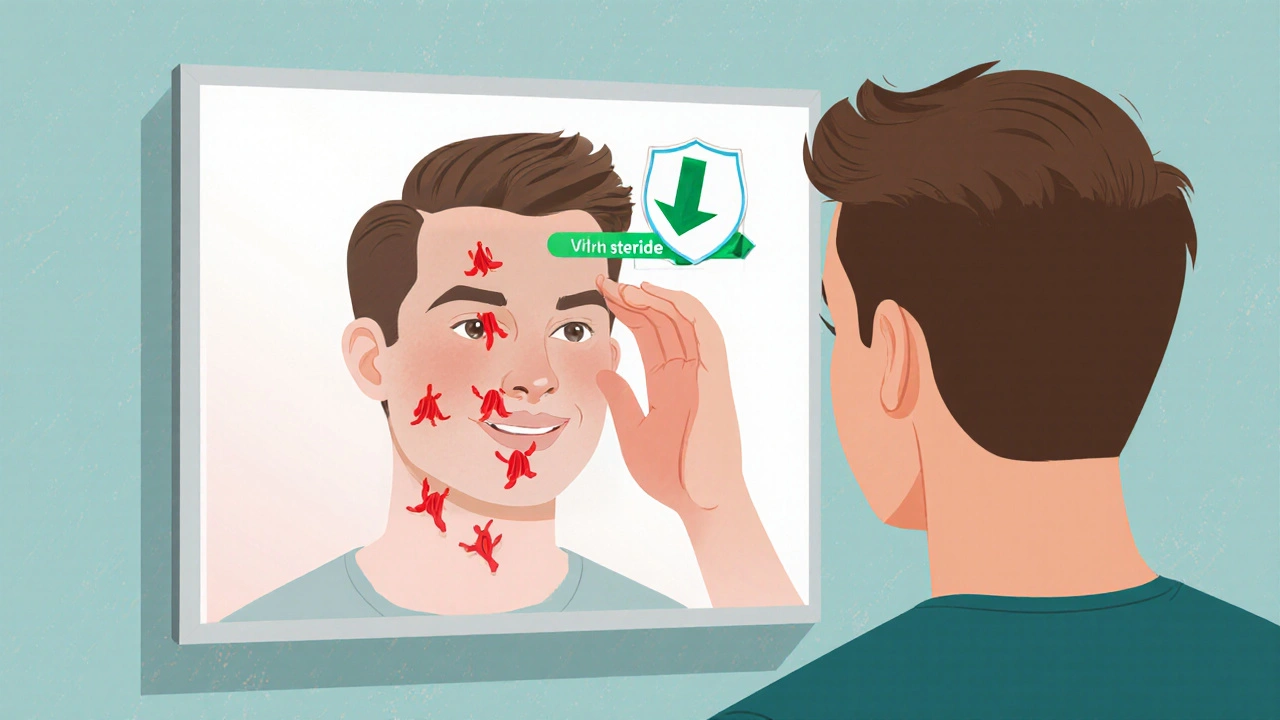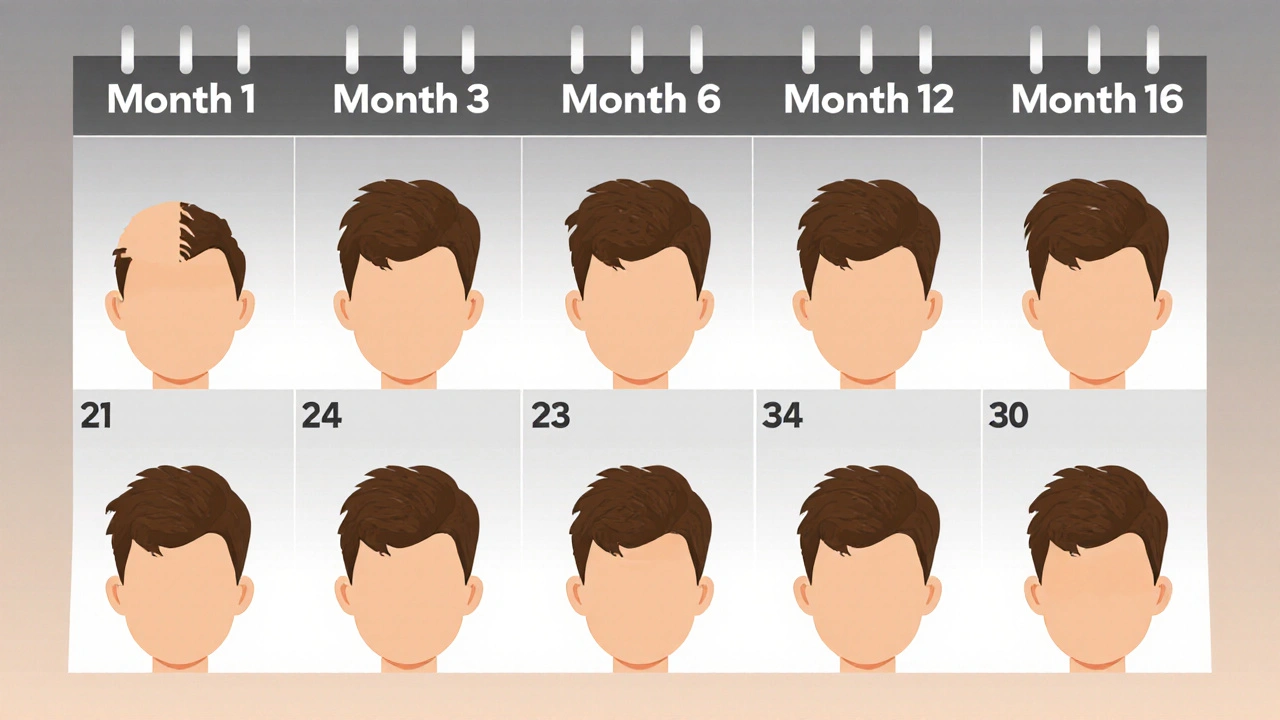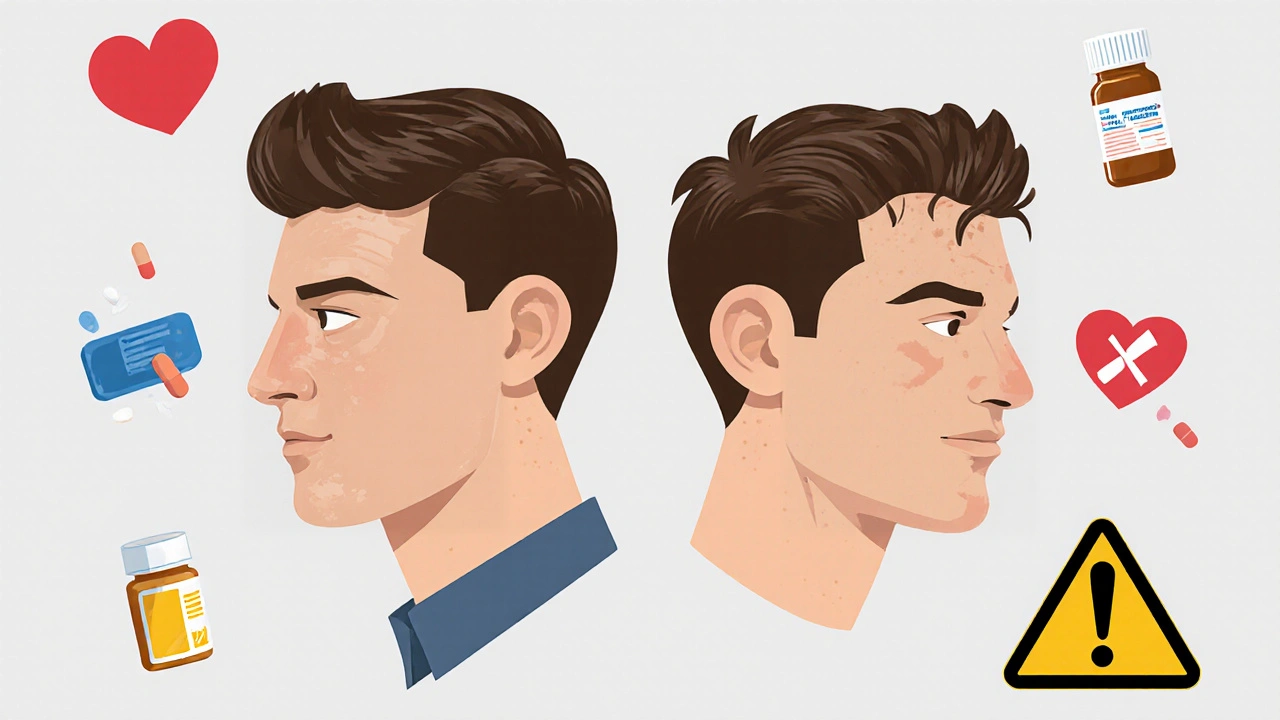Finasteride for Hair Loss Prevention: Is It Worth It?
 Oct, 27 2025
Oct, 27 2025
Every year, millions of men look in the mirror and notice their hairline creeping back. It’s not just about looks-it’s about confidence, identity, and feeling like yourself. That’s where finasteride comes in. It’s one of the most studied drugs for stopping hair loss, but it’s also one of the most debated. Is it worth it? Let’s cut through the noise and look at what actually happens when you take it.
What Finasteride Actually Does
Finasteride is a pill that blocks a hormone called DHT-dihydrotestosterone. This hormone is the main reason most men lose their hair. It shrinks hair follicles over time, making strands thinner and shorter until they stop growing altogether. Finasteride stops that process by cutting DHT levels in the scalp by about 60-70%. That’s not a small change. In clinical trials, men who took 1 mg of finasteride daily for a year saw a measurable slowdown in hair loss. About 83% of them stopped losing hair. And after two years, nearly 66% saw some regrowth, especially around the crown and mid-scalp.
It’s not magic. You won’t wake up with a full head of hair like you had in your 20s. But if you’re in the early stages of thinning-noticeable part widening, slight recession at the temples-finasteride can hold onto what you’ve got and even bring back some of it. The key is consistency. You have to take it every day. Miss a few days, and DHT starts creeping back. Skip it for weeks, and the hair you saved starts falling again.
How Long Does It Take to Work?
People expect quick results. They want to see thicker hair in a month. That’s not how finasteride works. Most men don’t notice anything for the first three to four months. That’s because hair grows in cycles. The drug doesn’t wake up dead follicles overnight-it gives existing ones a chance to recover. Around month six, some start seeing less shedding. By month 12, the real changes show up. That’s when you’ll know if it’s working for you.
One thing to watch: in the first few weeks, some men experience what’s called ‘shedding phase.’ It’s not a side effect-it’s a sign the drug is working. Old, weak hairs are being pushed out to make room for new, stronger ones. It can be scary if you don’t know it’s normal. But it usually lasts 2-4 weeks and then stops.
The Side Effects Nobody Talks About
Let’s be honest. The biggest reason people quit finasteride isn’t because it doesn’t work-it’s because of side effects. And they’re real. About 3-5% of men report sexual side effects: lower libido, trouble getting or keeping an erection, reduced semen volume. These usually show up within the first few months. For most, they go away when they stop the pill. But for a small group-studies suggest less than 1%-they persist even after stopping. That’s called Post-Finasteride Syndrome, and while rare, it’s serious enough to be documented in peer-reviewed journals like the Journal of Sexual Medicine.
Other possible side effects include breast tenderness, skin rashes, and mood changes like depression or anxiety. These are less common, but if they happen, you need to talk to your doctor. This isn’t something to push through. Your mental and physical health matter more than hair.
Here’s the thing: most men who take finasteride don’t have side effects. But if you’re someone who’s sensitive to hormonal changes-maybe you’ve had mood swings before, or your sex drive has been finicky-this might not be the right fit. Talk to a doctor before starting. Don’t buy it online without a prescription. Your body isn’t a lab experiment.

Who Benefits Most?
Finasteride works best for men with male pattern baldness-also called androgenetic alopecia. That’s the most common type: receding hairline, thinning crown, family history. It doesn’t work for women (unless they’re post-menopausal and under strict medical supervision), and it won’t help if your hair loss is from stress, illness, or nutrient deficiencies.
Age matters too. The earlier you start, the better the results. Men in their 20s and early 30s who catch thinning early have the highest chance of keeping or regrowing hair. By your late 40s or 50s, follicles may be too damaged to respond. That doesn’t mean it’s useless-it just means expectations need to be realistic. You’re not trying to look like a 25-year-old. You’re trying to stop looking like you’re 60 at 40.
Also, hair color and texture play a role. Men with thicker, darker hair tend to see more visible regrowth. Fine, light hair might improve in density but won’t look dramatically different.
Finasteride vs. Minoxidil: What’s the Difference?
Most people know finasteride. Fewer know about minoxidil-the topical solution you apply to your scalp. Minoxidil doesn’t touch DHT. Instead, it opens blood vessels in the scalp, feeding hair follicles more oxygen and nutrients. It’s like giving your hair a multivitamin. It works for both men and women.
Here’s how they compare:
| Feature | Finasteride | Minoxidil |
|---|---|---|
| How it works | Blocks DHT hormone | Stimulates blood flow to follicles |
| Form | Oral pill | Topical liquid or foam |
| Time to see results | 6-12 months | 3-6 months |
| Best for | Male pattern baldness | Thinning scalp, both men and women |
| Side effects | Potential sexual side effects | Scalp irritation, initial shedding |
| Requires daily use? | Yes | Yes |
| Reverses hair loss? | Yes, in many cases | Maintains, minor regrowth |
Many doctors recommend using both together. Finasteride stops the cause. Minoxidil boosts growth. Studies show the combo is more effective than either alone. But that also means doubling down on side effect risks. It’s a trade-off.

What Happens When You Stop?
This is the part people forget. Finasteride doesn’t cure baldness. It only works while you’re taking it. Stop the pill, and DHT levels bounce back within days. Hair loss resumes, usually within 6-12 months. You’ll lose whatever you gained-and possibly more, because the clock keeps ticking.
That’s why it’s not a quick fix. It’s a long-term commitment. If you’re not ready to take it for years-or maybe for life-you’re better off trying something else. Hair transplants, for example, offer permanent results. But they’re expensive, invasive, and not for everyone.
Is It Worth It?
Let’s cut to the chase. If you’re a man in your 20s or 30s with early signs of male pattern baldness, and you’re okay with taking a daily pill and monitoring for side effects, then yes-finasteride is worth it. It’s the most effective FDA-approved medication for preventing hair loss. It’s backed by decades of research, used by millions, and endorsed by dermatologists worldwide.
But if you’re already losing hair rapidly, have no family history, or are worried about sexual side effects, then maybe not. There are alternatives: low-level laser therapy, scalp micropigmentation, lifestyle changes like reducing stress and improving diet. Some men find success with natural supplements like saw palmetto, though the evidence is weaker.
Here’s the real question: How much does your hair matter to your quality of life? If losing it makes you anxious, avoids mirrors, or affects your confidence, then finasteride might be the best investment you make this year. If you’re okay with going bald and just want to delay it? Then it’s optional.
There’s no shame in either choice. But if you’re considering it, talk to a doctor. Get blood tests. Understand your hormone levels. Don’t let a YouTube ad or a friend’s story decide for you. This is your body. Make the decision with facts, not fear.
Does finasteride work for women?
Finasteride is not approved for women of childbearing age because it can cause birth defects in male fetuses. Post-menopausal women with hair loss may use it under strict medical supervision, but it’s not common. Women with female pattern hair loss usually benefit more from minoxidil or spironolactone.
Can finasteride cause infertility?
Some men report lower sperm count or reduced semen volume while taking finasteride, but these effects are usually reversible after stopping. There’s no strong evidence it causes permanent infertility. If you’re trying to conceive, talk to your doctor. You may need to pause the medication for a few months before attempting pregnancy.
Is 1 mg the right dose for hair loss?
Yes. The FDA-approved dose for hair loss is 1 mg per day. The 5 mg dose is used for enlarged prostate and is too strong for hair. Taking more won’t make it work better-it just increases side effect risk. Stick to 1 mg unless your doctor says otherwise.
How much does finasteride cost?
Generic finasteride costs between $10 and $30 per month in the U.S., depending on the pharmacy. Brand-name Propecia can be $70-$100. Many online pharmacies and international suppliers offer lower prices, but be cautious about quality. Always use a licensed provider.
Can I drink alcohol while taking finasteride?
Yes, alcohol doesn’t interfere with finasteride. But if you’re already experiencing low libido or mood changes, alcohol can make them worse. Moderation is always wise, especially when taking any medication that affects hormones.
What happens if I miss a dose?
If you miss one day, just take the next dose as scheduled. Don’t double up. Missing a few days won’t undo your progress, but the longer you skip, the more DHT builds up. Consistency matters more than perfection. Set a daily reminder if you need to.
Next Steps
If you’re thinking about trying finasteride, start here: Schedule a visit with a dermatologist or a doctor who specializes in hair loss. Ask for blood tests to check your testosterone, DHT, and thyroid levels. Rule out other causes. Get a scalp evaluation. Don’t rush into a prescription.
If you’re already taking it and worried about side effects, don’t panic. Track your symptoms. Talk to your doctor. You might need to adjust your dose or switch to another treatment. There’s no one-size-fits-all solution.
Hair loss is not a medical emergency. But it’s deeply personal. Whether you choose finasteride, go bald, or try something else-it’s your decision. Just make sure it’s informed, not influenced by hype or fear.
Marcia Martins
October 29, 2025 AT 16:59Just wanted to say I’m so glad someone wrote this without fearmongering 🙏 I’ve been on finasteride for 18 months and yes, I had that scary shedding phase-but then my part started filling in. Not a full head, but enough that I don’t avoid photos anymore. It’s not magic, but it’s peace of mind.
Robert Bowser
October 31, 2025 AT 16:16I tried it for six months, stopped because I was worried about side effects, and now I regret it. My hairline’s receding faster than ever. I wish I’d known how slow it is to work. You can’t expect results like a Netflix binge.
Sue M
November 1, 2025 AT 01:35It’s worth noting that the 83% stat refers to stopping hair loss-not regrowth. Many people misinterpret this. Also, the 66% regrowth figure is based on self-reported photos, not blinded assessments. Peer-reviewed data is more nuanced than YouTube summaries suggest.
Rachel Harrison
November 1, 2025 AT 17:01For anyone considering this: start low, track everything, and don’t panic about shedding. I used finasteride + minoxidil combo for 14 months. Lost 20% of hair in month 2, then gained back 30% by month 10. My dermatologist said my follicles looked healthier than my 35-year-old brother’s 😅
Tiffanie Doyle
November 3, 2025 AT 09:06yo i just started this last month and i was like oh no my hair is falling out more?? then i read about the shedding phase and was like ohhhhhhh okkkkkk lol. its weird but kinda comforting to know its not all going to hell. also i drink coffee like its water and no issues so far 🤞
james landon
November 3, 2025 AT 21:33bro i took it for 3 months, lost my libido, got depressed, and still lost hair. now i’m bald and emotionally drained. why do people act like this is some miracle cure? it’s a hormonal grenade. i’d rather be bald and happy than half bald and numb.
Jenn Clark
November 4, 2025 AT 03:52I’m from a culture where baldness is seen as wisdom, not failure. I never felt pressure to fight it. But I respect those who do. This post was balanced and kind. Thank you for not making people feel broken for choosing differently.
L Walker
November 4, 2025 AT 04:08Interesting how the cost comparison doesn’t mention insurance coverage. In the UK, NHS doesn’t cover it for hair loss-so you pay full whack. Also, generic finasteride from India can be 90% cheaper, but quality control? Not guaranteed. Always check the manufacturer’s license.
giri pranata
November 5, 2025 AT 08:18From India here-my cousin took it for 2 years, had zero side effects, and now his hair looks like it’s 2012 again. He’s a gym guy, eats clean, sleeps well. Maybe lifestyle matters as much as the pill? Also, saw palmetto didn’t do squat for him. Finasteride was the only thing that moved the needle.
Stuart Rolland
November 5, 2025 AT 08:23I’ve been on finasteride for five years now. I started at 27 when I noticed my temples thinning. I didn’t have any side effects, but I also didn’t expect miracles. What I got was stability. My hair didn’t get thicker, but it didn’t disappear either. That’s huge. I’ve seen friends go from full heads to bald in five years just by doing nothing. I’m not trying to look like a 22-year-old-I’m trying to look like the same guy I was at 27. And honestly? That’s enough. The real win isn’t the hair-it’s not having to stress about it every morning. You wake up, look in the mirror, and it’s still there. No panic. No dread. Just… normal. That’s worth the daily pill. I know some people say it’s not worth the risk, but for me, the risk of losing my confidence was way higher than the chance of a side effect. I’ve talked to my doctor, gotten bloodwork, and I’m monitoring everything. It’s not a magic bullet, but it’s a tool. And sometimes, tools are all you need to keep your sense of self intact.